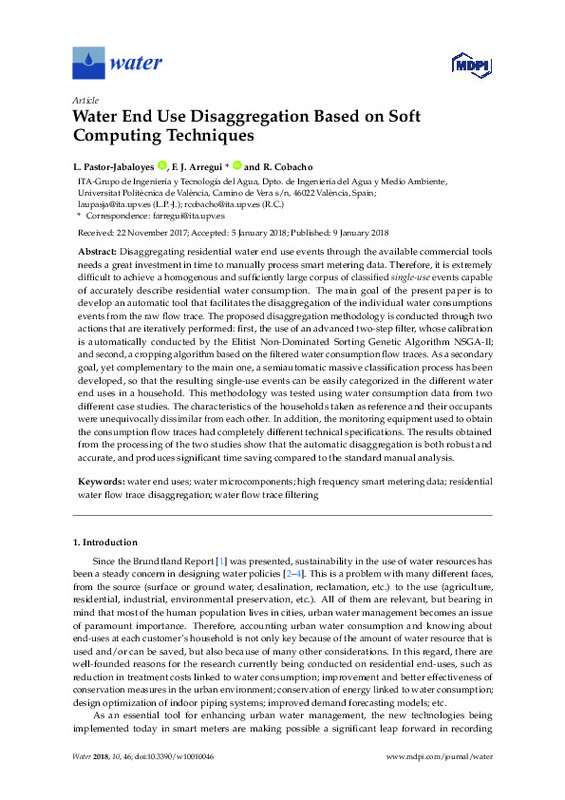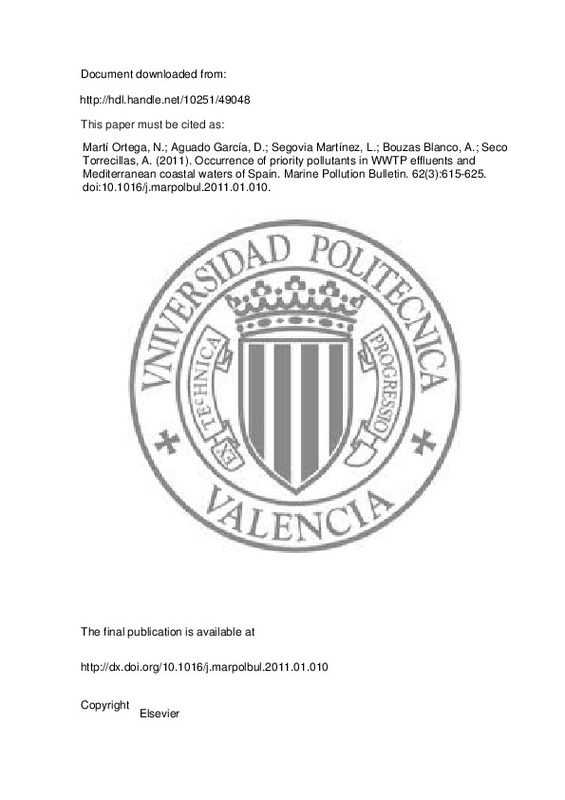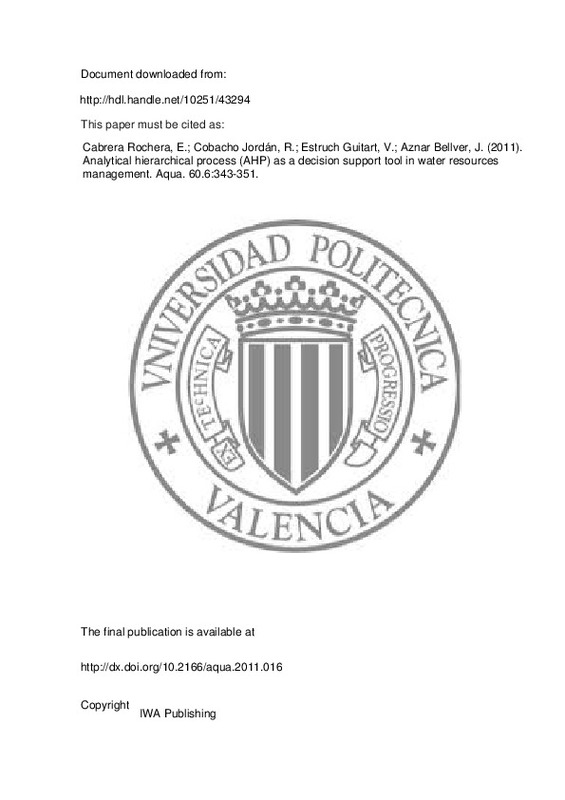JavaScript is disabled for your browser. Some features of this site may not work without it.
Buscar en RiuNet
Listar
Mi cuenta
Estadísticas
Ayuda RiuNet
Admin. UPV
Water End Use Disaggregation Based on Soft Computing Techniques
Mostrar el registro sencillo del ítem
Ficheros en el ítem
| dc.contributor.author | Pastor-Jabaloyes, Laura
|
es_ES |
| dc.contributor.author | Arregui de la Cruz, Francisco
|
es_ES |
| dc.contributor.author | Cobacho Jordán, Ricardo
|
es_ES |
| dc.date.accessioned | 2019-05-11T20:04:01Z | |
| dc.date.available | 2019-05-11T20:04:01Z | |
| dc.date.issued | 2018 | es_ES |
| dc.identifier.issn | 2073-4441 | es_ES |
| dc.identifier.uri | http://hdl.handle.net/10251/120353 | |
| dc.description.abstract | [EN] Disaggregating residential water end use events through the available commercial tools needs a great investment in time to manually process smart metering data. Therefore, it is extremely difficult to achieve a homogenous and sufficiently large corpus of classified single-use events capable of accurately describe residential water consumption. The main goal of the present paper is to develop an automatic tool that facilitates the disaggregation of the individual water consumptions events from the raw flow trace. The proposed disaggregation methodology is conducted through two actions that are iteratively performed: first, the use of an advanced two-step filter, whose calibration is automatically conducted by the Elitist Non-Dominated Sorting Genetic Algorithm NSGA-II; and second, a cropping algorithm based on the filtered water consumption flow traces. As a secondary goal, yet complementary to the main one, a semiautomatic massive classification process has been developed, so that the resulting single-use events can be easily categorized in the different water end uses in a household. This methodology was tested using water consumption data from two different case studies. The characteristics of the households taken as reference and their occupants were unequivocally dissimilar from each other. In addition, the monitoring equipment used to obtain the consumption flow traces had completely different technical specifications. The results obtained from the processing of the two studies show that the automatic disaggregation is both robust and accurate, and produces significant time saving compared to the standard manual analysis. | es_ES |
| dc.description.sponsorship | This study has received funding by the IMPADAPT project /CGL2013-48424-C2-1-R from the Spanish ministry MINECO with European FEDER funds and from the European Union's Seventh Framework Programme (FP7/2007-2013) under grant agreement No. 619172 (SmartH2O: an ICT Platform to leverage on Social Computing for the efficient management of Water Consumption). | es_ES |
| dc.language | Inglés | es_ES |
| dc.publisher | MDPI AG | es_ES |
| dc.relation.ispartof | Water | es_ES |
| dc.rights | Reconocimiento (by) | es_ES |
| dc.subject | Water end uses | es_ES |
| dc.subject | Water microcomponents | es_ES |
| dc.subject | High frequency smart metering data | es_ES |
| dc.subject | Residential water flow trace disaggregation | es_ES |
| dc.subject | Water flow trace filtering | es_ES |
| dc.subject.classification | MECANICA DE FLUIDOS | es_ES |
| dc.subject.classification | INGENIERIA HIDRAULICA | es_ES |
| dc.title | Water End Use Disaggregation Based on Soft Computing Techniques | es_ES |
| dc.type | Artículo | es_ES |
| dc.identifier.doi | 10.3390/w10010046 | es_ES |
| dc.relation.projectID | info:eu-repo/grantAgreement/EC/FP7/619172/EU/SmartH2O: an ICT Platform to leverage on Social Computing for the efficient management of Water Consumption/ | es_ES |
| dc.relation.projectID | info:eu-repo/grantAgreement/MINECO//CGL2013-48424-C2-1-R/ES/ADAPTACION AL CAMBIO GLOBAL EN SISTEMAS DE RECURSOS HIDRICOS/ | es_ES |
| dc.rights.accessRights | Abierto | es_ES |
| dc.contributor.affiliation | Universitat Politècnica de València. Departamento de Ingeniería Hidráulica y Medio Ambiente - Departament d'Enginyeria Hidràulica i Medi Ambient | es_ES |
| dc.description.bibliographicCitation | Pastor-Jabaloyes, L.; Arregui De La Cruz, F.; Cobacho Jordán, R. (2018). Water End Use Disaggregation Based on Soft Computing Techniques. Water. 10(1). https://doi.org/10.3390/w10010046 | es_ES |
| dc.description.accrualMethod | S | es_ES |
| dc.relation.publisherversion | http://doi.org/10.3390/w10010046 | es_ES |
| dc.type.version | info:eu-repo/semantics/publishedVersion | es_ES |
| dc.description.volume | 10 | es_ES |
| dc.description.issue | 1 | es_ES |
| dc.relation.pasarela | S\355648 | es_ES |
| dc.contributor.funder | European Commission | es_ES |
| dc.contributor.funder | Ministerio de Economía, Industria y Competitividad | es_ES |











